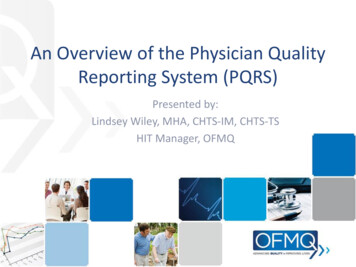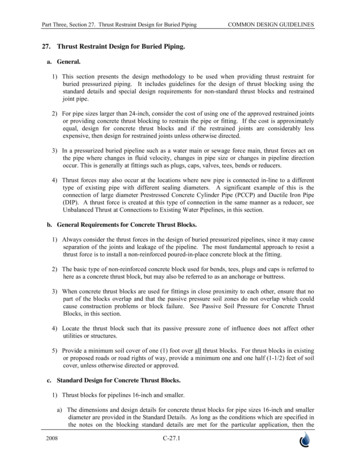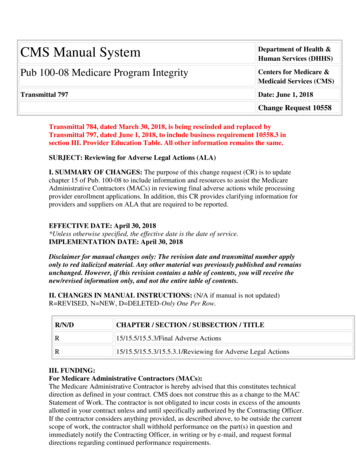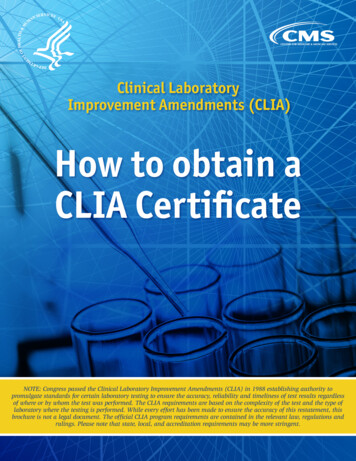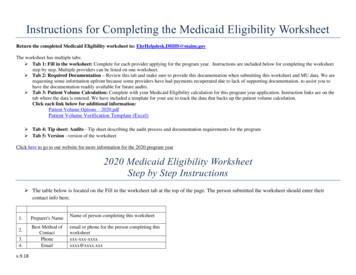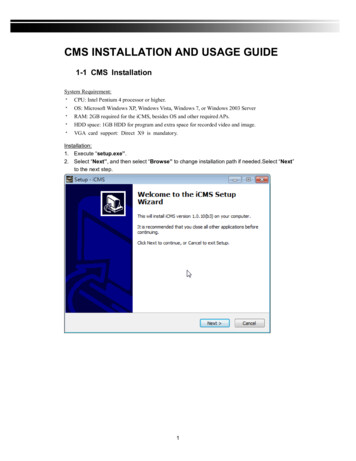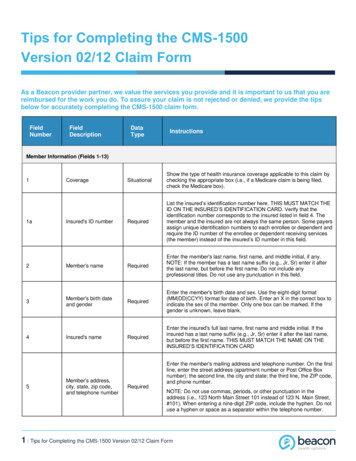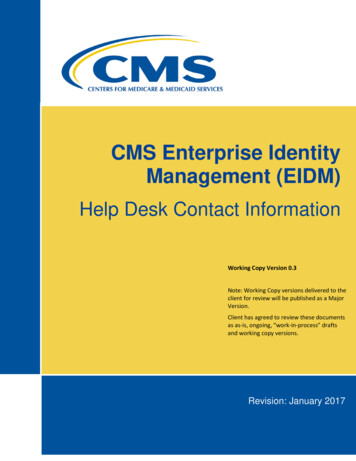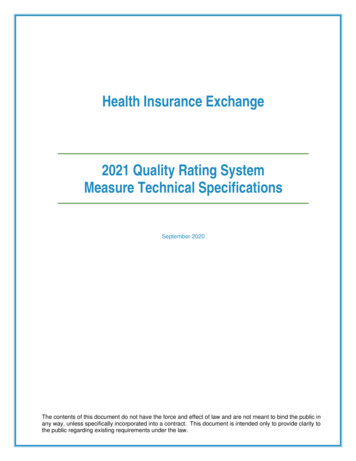
Transcription
The CMSRestraint TrainingRequirementsHandbookUse of restraint and seclusion is fraught with difficulties and istherefore a top focus of CMS and other regulatory bodies. Thishandbook is a quick way to cover the rules and how to applythem.The CMS Restraint Training Requirements Handbook is aperfect resource to reference on the go. It covers everything youneed to ensure you have the knowledge to safely use restraintand seclusion techniques and follow all the CMS guidelines.This book will help you:»»»»»Administer the application of restraintsUnderstand the implementation of seclusionMonitor patients in restraint/seclusionProperly assess patients in restraint/seclusionProvide care to restrained/secluded patientsThe CMSRestraint TrainingRequirementsHandbookCMSRT275 Sylvan Street Suite A-101Danvers, MA 01923www.hcmarketplace.com31607 VBPHB BookCover.indd 11/18/16 10:10 AM
The CMSRestraint TrainingRequirementsHandbook
The CMS Restraint Training Requirements Handbook is published by HCPro, a divisionof BLR.Copyright 2016 HCPro, a division of BLRAll rights reserved. Printed in the United States of America. 5 4 3 2 1ISBN: 978-1-55645-939-9No part of this publication may be reproduced, in any form or by any means, withoutprior written consent of HCPro or the Copyright Clearance Center (978-750-8400).Please notify us immediately if you have received an unauthorized copy.HCPro provides information resources for the healthcare industry.HCPro is not affiliated in any way with The Joint Commission, which owns the JCAHOand Joint Commission trademarks.Elizabeth Di Giacomo-Geffers, RN, MPH, CSHA, ReviewerDoris Herrlin, RN, MPA, ReviewerJay Kumar, Associate Product ManagerErin Callahan, Vice President, Product Development & Content StrategyElizabeth Petersen, Executive Vice President, HealthcareMatt Sharpe, Production SupervisorVincent Skyers, Design Services DirectorVicki McMahan, Sr. Graphic DesignerMichael McCalip, Layout/Graphic DesignJason Gregory, Cover DesignerAdvice given is general. Readers should consult professional counsel for specific legal,ethical, or clinical questions.Arrangements can be made for quantity discounts. For more information, contact:HCPro100 Winners Circle, Suite 300Brentwood, TN 37027Telephone: 800-650-6787 or 781-639-1872Fax: 800-785-9212Email: customerservice@hcpro.comVisit HCPro online at www.hcpro.com and www.hcmarketplace.com
ContentsIntroduction. 1The Training Requirements. 3Safe application of restraints.4Implementation of seclusion.5Monitoring of patients in restraint/seclusion.5Assessment of patients in restraint/seclusion.6Providing care for a patient in restraint or seclusion.7Techniques to identify triggers of circumstances that requireuse of restraint or seclusion.7Use of nonphysical intervention skills.8Choosing the least-restrictive intervention.8Safe application and use of all types of restraint and seclusionused in the facility.9Clinical identification of specific behavioral changes that indicate restraint is no longer needed.9Monitoring physical well-being of patient.10Use of first aid techniques and certification in CPR use.11Death Reporting. 11Sample Competency Form: Application ofRestraints. 14 2016 HCProiii
The CMS Restraint Training Requirements HandbookSample Competency Form: Restraints(Role of Nursing Assistant). 16Sample Competency Form: Seclusion Restraint (BehavioralHealth). 18CMS Death Reporting Requirements.21A-0213.21A-0214.25Quiz Questions. 30Quiz Answers. 32iv 2016 HCPro
The CMS Restraint TrainingRequirements HandbookIntroductionIn January 2007, new patients’ rights regulations from the Centers for Medicare & Medicaid Services (CMS) went into effect,requiring hospitals to rewrite their policies about restraint andseclusion. The new regulations in the Conditions of Participation(CoP) set forth, among other things, new training requirements.There are five sections to the patients’ rights standards. The firstfour sections were published without making any changes to thecurrent CoP. The fifth section includes the patient’s right to befree from unnecessary restraint and seclusion. This section combined two separate sections on medical and surgical restraintsand behavioral health restraints. It includes 14 rules on restraintand seclusion, covering:§§ Freedom from restraint and seclusion§§ Less restrictive interventions§§ Orders 2016 HCPro1
The CMS Restraint Training Requirements §NotificationCare plansDiscontinuationAssessment and reassessmentPerformance improvementUseTime limitsRenewalStaff educationMonitoringDeath protocolIt’s important to understand that the core definition of restraintremains essentially the same, with the distinction between themore restrictive time limitations clarified, not changed. Thenew definition says a restraint is any manual method, physicalor mechanical device, material, or equipment that immobilizesor reduces the ability of a patient to move his or her arms, legs,body, or head freely. It also includes a drug or medication whenit is used as a restriction to manage the patient’s behavior orrestrict the patient’s freedom of movement and is not a standardtreatment or dosage for the patient’s condition. CMS says allpatients have the right to be free from physical or mental abuseand corporal punishment. All patients have the right to be freefrom restraint or seclusion, of any form, imposed as a means ofcoercion, discipline, convenience, or retaliation by staff. Restraintor seclusion may be imposed only to ensure the immediate physical safety of the patient, a staff member, or others and must bediscontinued at the earliest possible time.A restraint does not include devices—such as orthopedicallyprescribed devices, surgical dressings or bandages, protective2 2016 HCPro
The CMS Restraint Training Requirements Handbookhelmets, or other methods that involve the physical holding of apatient for the purpose of:§§ Conducting routine physical examinations or tests§§ Permitting the patient to participate in activities without the risk of physical harm (this does not include aphysical escort)The definition of seclusion—the involuntary confinement of aperson in a room or area in which the person is physically prevented from leaving—did not change.Those who provide staff training on restraint and seclusion usemust be qualified as evidenced by education, training, and experience in techniques used to address patient behaviors, accordingto the new regulations. All direct care staff must receive trainingin the hospital’s restraint and seclusion policies and approaches,and all staff who may be involved in the use of restraint must betrained in safe use of restraint, including the use of mechanicalrestraint devices, takedowns, and holding.Hospital leadership sets the standards for the current restraintand seclusion policies (medical/surgical and behavioral). Thepolicies should set clear expectations for a safe environment inwhich restraint and seclusion are used only as a last resort. Staffis expected to commit to minimizing the factors that might resultin the need to restrain or seclude a patient.The Training RequirementsThe patient has the right to safe implementation of restraintor seclusion by trained staff. You must be able to demonstratecompetency in the application of restraints, implementation of seclusion, monitoring, assessment, and providing care for a patientin restraint or seclusion. Training should take place before staff 2016 HCPro3
The CMS Restraint Training Requirements Handbookperform any of the actions specified in the training requirements,as part of orientation, and subsequently on a periodic basis consistent with hospital policy.Individuals providing staff training must be qualified as evidenced by education, training, and experience in techniques usedto address patient behavior. The hospital must document in staffpersonnel records that the training and demonstration of competency were successfully completed.The new regulations spell out the following restraint and seclusion training requirements for staff.Safe application of restraintsYou should be able to demonstrate and ensure that when youselect a type of restraint, you take the following steps:§§ Select the proper size for the patient’s weight.§§ Note “front” and “back” of the restraint andapply correctly.§§ Pad any bony prominences.§§ Use a knot that can easily be released (half-bow).§§ Secure restraints to the bed springs or frame, never to themattress or bed rails. When an adjustable bed is in use,secure the restraints to the parts of the bed that movewith the patient. Never secure a restraint to a bed railor mattress.§§ Adjust restraint to maintain good body alignment,comfort, and safety.§§ Ensure restraints are not too tight. (Test to be certain thatyou can insert two fingers in between restraint and skin.)4 2016 HCPro
The CMS Restraint Training Requirements HandbookImplementation of seclusionYou need to demonstrate knowledge of the definition of seclusion, which is the involuntary confinement of a person alone ina room or an area where the person is physically prevented fromleaving. Seclusion does not include confinement on a locked unitor ward where the patient is with others. Seclusion may be usedonly for the management of violent or self-destructive behavior.Seclusion is seldom used in general healthcare settings.Monitoring of patients in restraint/seclusionYou must be able to discuss the monitoring of a patient in restraints. The condition of the patient who is restrained or secluded must be monitored by a physician, other licensed independentpractitioner (LIP), or trained staff that have completed the CMStraining requirements.This monitoring includes:§§ Ensuring the physical and emotional well-being ofthe patient§§ Maintaining the patient’s rights, dignity, and safety§§ Documenting the type, location, and proper application ofthe restraining device(s)––§§Assessing the rationale for restraint on an ongoing basis––§§Documented at least once per shift and whenchangedDocumented at least once per shift (observedcondition or behavior)Considering alternatives to and less-restrictive formsof restraint–– 2016 HCProDocumented at least once per shift5
The CMS Restraint Training Requirements Handbook§§Completing other monitoring activities based on the currently approved medical restraint form––Documented per policyAssessment of patients in restraint/seclusionYou should conduct an initial assessment of a patient at the timeof the patient’s admission to determine whether restraint is necessary. The assessment should include the following:§§ Consideration of medical conditions or disability thatmight increase the risk of harm to the patient during arestraint episode§§ Any history of sexual or physical abuse that might increase the risk to the patient during restraint§§ Documentation that the patient—and, if appropriate, thepatient’s family—was informed of the organization’s philosophy regarding use of restraint or seclusionYou must, when appropriate, discuss the role of the family inrelation to restraint with the patient and family. You must alsodetermine whether the patient has a mental health advance directive, which should indicate the patient’s preference for treatment in case the patient becomes dangerous to him- or herself orothers. If the patient has an advance directive, the hospital mustprovide the information to staff.When restraint or seclusion is used for the management of violent or self-destructive behavior that jeopardizes the immediatephysical safety of the patient, a staff member, or others, the patient must be seen face-to-face within one hour after the initiationof the intervention. The patient may be assessed by a physicianor other LIP or a registered nurse or physician assistant who hasbeen trained in the CMS restraint and seclusion training requirements. Check to see whether your state has stricter requirements.6 2016 HCPro
The CMS Restraint Training Requirements HandbookIf the face-to-face evaluation is conducted by a trained registered nurse or physician assistant, that individual must consultthe attending physician or other LIP who is responsible for thepatient’s care as soon as possible after the completion of the onehour face-to-face evaluation.Simultaneous restraint and seclusion use is permitted only ifthe patient is continually monitored face-to-face by an assigned,trained staff member or by trained staff using both video andaudio equipment.Staff authorized to carry out restraint must be trained to measurevital signs and know the relevance of vital signs to restrainedpatients. They must be able to recognize and respond to needsfor nutrition and hydration, proper circulation and movement oflimbs, and hygiene and elimination.Providing care for a patient in restraint or seclusionYou should modify the patient’s written plan of care to indicatethe type of restraint and the goals of the restraint use.Techniques to identify triggers of circumstances thatrequire use of restraint or seclusionYou should watch for the following indications to consider usingrestraint or seclusion when less restrictive means would not beeffective in protecting the patient:§§ The patient is pulling at tubes, lines, or dressings§§ The confused patient is interfering with the provisionof care§§ The patient’s actions are endangering him- or herself:for example, if the patient is thrashing around in bed orattempting to get out of bed in a way or under conditions 2016 HCPro7
The CMS Restraint Training Requirements Handbook§§where it might cause harm (including when such behavior is related to acute withdrawal syndrome)The patient’s diagnosis or condition is such that he orshe may unpredictably and suddenly awaken and harmhim- or herself; e.g., when an intubated patient is beingweaned from propofol or when an intubated patient hasa neurological condition that may cause him or her tounpredictably and suddenly awaken with a significantrisk of self-extubation before staff have an opportunityto interveneUse of nonphysical intervention skillsYou should be well versed in the use of nonphysical interventionskills, such as verbal and nonverbal communication, reducedstimulation, active listening, diversionary techniques, limit setting, and as-needed (PRN) medication.Choosing the least-restrictive interventionRestraint should not be used when less-restrictive interventionswould be effective. These include environmental techniquessuch as:§§ Designing the clinical unit to avoid patient crowding andprovide some settings where patients can be by themselves to calm down§§ Providing easy access to staff and facilitation of conversation with staff as a means of blowing off steam orgetting advice§§ Access to activities that will either preoccupy the patient’sattention or use up physical energy (e.g., interesting videos or exercise equipment)Another type of less-restrictive intervention consists of steps thatstaff should take on the spot when it appears an individual is8 2016 HCPro
The CMS Restraint Training Requirements Handbookabout to go into crisis. These steps are generally called de-escalation and are heavily dependent on proper staff training to recognize the situation and deal with it.Safe application and use of all types of restraint andseclusion used in the facilityYou must consider the following information when selecting thetype of restraint you will use:§§ The patient’s expressed preference provided at admissionin the advance directive§§ The initial assessment, which contains the patient’s history, physical strength and limitations, and vulnerabilities§§ The dimensions of the emergency that the restraint isintended to endYou should receive training in how to recognize andrespond to signs of physical and psychological distress (e.g.,positional asphyxia).Among the restraint options a hospital might consider having available are four-point leather restraints, two-pointrestraints, Posey vests, and seclusion. You need to be able todemonstrate and follow the manufacturer’s directions whenapplying restraints.Clinical identification of specific behavioral changesthat indicate restraint is no longer neededYou must discontinue the restraint when the behavior or condition that was the basis for the restraint order is resolved, regardless of the duration of the enabling order. You should be able torecognize the behavioral criteria for discontinuation of restraint 2016 HCPro9
The CMS Restraint Training Requirements Handbookand assist patients in meeting these criteria. If you are not permitted to make the decision to discontinue restraint, you must callsupervisory staff, who will then make the decision to release.Monitoring physical well-being of patient§§Continuous, in-person observation:Monitoring of patients in restraint or seclusion is donethrough continuous in-person observation by a trainedand competent staff member––§§If the patient is on a physical hold, asecond staff person shall be assigned to observethe patientMonitoring:––You should assess the patient at the initiation of restraint or seclusion and every 15minutes thereafter––The assessment should include the following,unless it is inappropriate for the type of restraintor seclusion ns of any injury associated withapplying restraint or seclusionNutrition and hydrationCirculation and range of motion inthe extremitiesVital signsLevel of distress and agitationSkin integrityMental statusCognitive functioningHygiene and elimination 2016 HCPro
The CMS Restraint Training Requirements Handbook§§§§Physical and psychological statusand comfortReadiness for discontinuation of restraintor seclusionUse of first aid techniques and certification in CPR useYou should be able to demonstrate competency in the use of firstaid techniques and certification in the use of cardiopulmonaryresuscitation, including required periodic recertification.Death ReportingPreviously, hospitals were required to report deaths that occurredwhile a patient was in restraint or seclusion, deaths that occurredwithin 24 hours after a patient was removed from restraint orseclusion, and deaths known to the hospital that occurred withinone week after restraint or seclusion of the patient.But in November 2013, CMS released a new death reporting form,CMS-10455, and modified its reporting requirements related tothe use of restraint or seclusion. Hospitals no longer must reportdeaths to CMS if there was no use of seclusion and the onlyrestraint used was two-point soft wrist restraints (CFR 482.13(g)).Staff must record the incident in an internal log or other system.The final rule also expanded the requirement to allow submissionof death reports via telephone, facsimile, or mail. Email is not anacceptable means of reporting.Hospitals must report the following deaths associated with restraint and seclusion directly to their CMS regional office no later 2016 HCPro11
The CMS Restraint Training Requirements Handbookthan the close of business on the next business day after learningof the patient’s death:§§ Each death that occurs while a patient is in restraint orseclusion, excluding those in which only two-point softwrist restraints were used and the patient was not in seclusion at the time of death§§ Each death that occurs within 24 hours after the patienthas been removed from restraint or seclusion, excludingthose in which only two-point soft wrist restraints wereused and the patient was not in seclusion within 24 hoursof his or her death§§ Each death known to the hospital that occurs within oneweek after restraint or seclusion where it is reasonableto assume that use of restraint or placement in seclusioncontributed directly or indirectly to a patient’s death,regardless of the types of restraints used on the patientduring this timeHospitals must record deaths that occur in the following circumstances in an internal hospital log or other system:§§ Each death that occurs while a patient is in restraint butnot seclusion and the only restraints used on the patientwere applied exclusively to the patient’s wrist(s) and werecomposed solely of soft, nonrigid, cloth-like materials§§ Each death that occurs within 24 hours after the patienthas been removed from restraint, when no seclusion hasbeen used and the only restraints used on the patientwere applied exclusively to the patient’s wrist(s) and werecomposed solely of soft, nonrigid, cloth-like materials12 2016 HCPro
The CMS Restraint Training Requirements HandbookThe log entry must be made no later than seven days after thepatient’s death. The log must include the information specified in42 CFR 482.13(g)(4)(ii), which includes:§§ Patient’s name§§ Date of birth§§ Date of death§§ Name of attending physician or other LIP who is responsible for the care of the patient§§ Medical record number§§ Primary diagnosis/diagnosesThe following must also be documented in the medical record forany patient whose death is associated with the use of restraintor seclusion:§§ The date and time the death was reported to CMS fordeaths required to be directly reported§§ The date and time the death was recorded in the hospital’s internal log or other system for deaths that arerequired to be logged and not directly reported to CMS 2016 HCPro13
The CMS Restraint Training Requirements HandbookSample Competency Form: Application ofRestraintsName: Date:Restraints, application ofSkill:StepsCompleted Comments1. Verbalizes need to assess patientsrequiring restraints and identifiesalternative to restraints2. Identifies nurse’s and physician’sroles in application of restraints3. Describes time frame for patientassessment/ documentation4. Documents restraints on restraintlog (including date, time, medicalrecord number, etc.)5. Chest restrainta. Applies chest restraint andadjusts waist belt to fitb. Demonstrates how to secure tobedspring frame (not side rails)or back frame of wheelchair6. Soft restraintsa. Verbalizes criteria for application of restraints to extremities(single restraint, wrists only, allextremities)b. Applies soft restraint to extremityand removes14 2016 HCPro
The CMS Restraint Training Requirements HandbookStepsCompleted Comments7. Mitt restraintsa. Applies mitt restraint8. Leather restraintsa. Verbalizes role of personnel inapplying leather restraintsb. Applies according to onLevelsType ofCommentsvalidationmethods Experienced Verbal Need practice Demonstration/ Intermediate Never done Not applicable(based onobservation Beginner Expert Orientation Annual Other Practicalexercisescope of Interactivepractice)classEmployee signature DateObserver signature Date 2016 HCPro15
The CMS Restraint Training Requirements HandbookSample Competency Form: Restraints(Role of Nursing Assistant)Name: Date:Restraints (role of nursing assistant)Skill:StepsCompleted Comments1. Verbalizes nursing assistant’srole in safety evaluation ofrestraints2. States how and where to document restraints3. Soft restraints:a. Demonstrates how to removeand reapply softrestraints to extremitiesb. Demonstrates how to secureto bedspring frame(not side rails) using slipknot4. Mitt restraints:a. Demonstrates how to removeand reapply unitrestraints5. Leather restraints (optional):a. Demonstrates how to removeand reapply leatherrestraints16 2016 HCPro
The CMS Restraint Training Requirements Type ofCommentsvalidationmethods Experienced Verbal Need practice Demonstration/ Intermediate Never done Not applicable(based onobservation Beginner Expert Orientation Annual Other Practicalexercisescope of Interactivepractice)classEmployee signature DateObserver signature Date 2016 HCPro17
The CMSRestraint TrainingRequirementsHandbookUse of restraint and seclusion is fraught with difficulties and istherefore a top focus of CMS and other regulatory bodies. Thishandbook is a quick way to cover the rules and how to applythem.The CMS Restraint Training Requirements Handbook is aperfect resource to reference on the go. It covers everything youneed to ensure you have the knowledge to safely use restraintand seclusion techniques and follow all the CMS guidelines.This book will help you:»»»»»Administer the application of restraintsUnderstand the implementation of seclusionMonitor patients in restraint/seclusionProperly assess patients in restraint/seclusionProvide care to restrained/secluded patientsThe CMSRestraint TrainingRequirementsHandbookCMSRT275 Sylvan Street Suite A-101Danvers, MA 01923www.hcmarketplace.com31607 VBPHB BookCover.indd 11/18/16 10:10 AM
This book will help you: » Administer the application of restraints . Use of first aid techniques and certification in CPR use. 11 Death Reporting . patients have the right to be free from physical or mental abuse and corporal punishment
